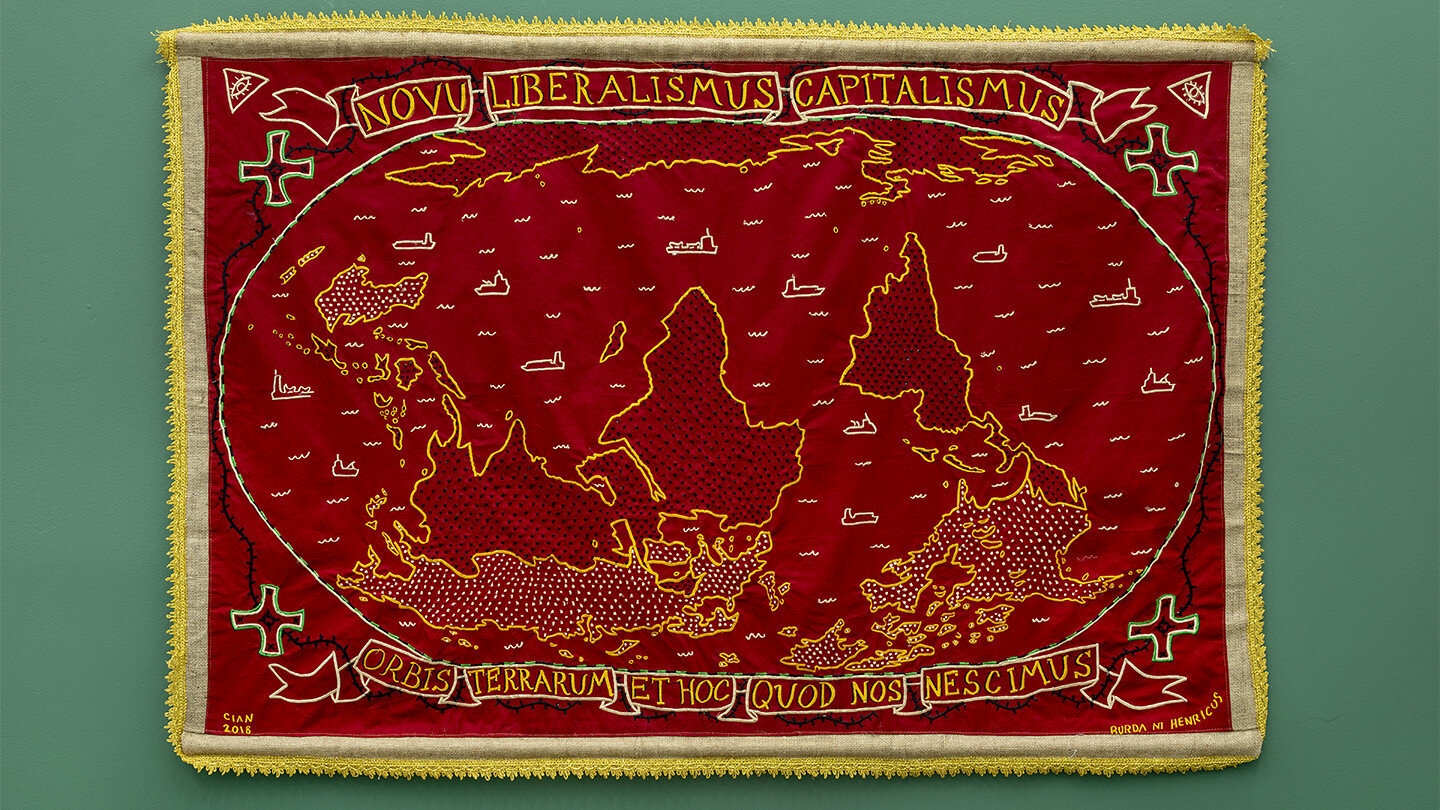March 17–May 27, 2023
Old College
University of Edinburgh
Edinburgh EH8 9YL
UK
Hours: Tuesday–Saturday 10am–5pm
T +44 131 650 2210
info.talbotrice@ed.ac.uk
Talbot Rice Gallery announces the opening of The Accursed Share, featuring artists Marwa Arsanios, Sammy Baloji, Cian Dayrit, Moyra Davey, Hanna von Goeler, Goldin+Senneby, Lubaina Himid, Hana Miletić, and terra0.
The history of monetary debt is one of startling violence: the sovereign figurehead on the banknotes in your pocket is an echo of centuries of empire-building, colonisation, evictions, enslavement, exploitation and militarisation. At a time of spiralling debts and the cost-of-living crisis, the nine artists and groups in The Accursed Share expose this wretched system and celebrate attempts to resist it.
Land and extraction are key. Marwa Arsanios looks at the global struggles of women trying to reconnect to nature. Part 4: Reverse Shot (2022)—her latest film shown at documenta fifteen—is an attempt to reverse decades of colonialism, civil war and privatisation by turning an area of land in Lebanon into a common land. Goldin+Senneby’s The Plot (Utopia Bloemen) (2018) is based on land they acquired in Belgium on top of a former coal mine. Pushing en plein air (“outside”) painting, they centre the work on a portable artist’s box that includes the deeds to the land and a poem by Mustafa Kör, whose father was a miner there. Transforming 350-million-year-old fossils into a wall mural, they evoke both deep time and the human desires that haunt the plot. terra0 set out in 2016 to create a technically augmented forest, that—armed with artificial intelligence and capable of trading digital currencies—would be given the agency to ensure its own survival—a vision to empower ecosystems against harmful economic practices.
War and oppression are present in many works. Sammy Baloji’s Untitled (2018 / 2023) will bring 50 copper gun shells into the gallery. Potted with plants from the Katanga region of the Democratic Republic of the Congo, they are symbolic of the history of African traditions being smashed by the drive for free trade: from millions lost under the rule of King Leopold II of Belgium, to those forced into labour in the mines, the role of copper and African people in two World Wars, to the current use of these gun shells as planters for middle-class households. Cian Dayrit works through historical and ongoing issues of militarism, corruption and oppression in the Philippines. His collaborations with indigenous and disposed communities map the monsters that divide territories up into resources for exploitation, just as they aim to record the culture of peoples who might disappear.
Then money. Moyra Davey’s Copperheads (1990–ongoing) see the artist turn her meticulous attention to the Lincoln Cent, minted since 1909. Photographing it with a macro lens to create large, detailed colour prints, it shows the dirt, patinas and scars of objects caught between lumpen materiality and remote governmental attempts to control value. Hanna von Goeler’s paintings of birds on top of defunct banknotes speak to nature’s traversal of human territories and to its vulnerability—with birds on the front line of the ecological crisis. The notes suggest collective yet extinct visions of civilisation and statehood.
Alternative forms of debt are owed to mothers, traditions and communities. Hana Miletić’s painstaking woven recreations of signs of care and repair in the city evoke something precious that cannot be recouped by capitalism. It documents the subtle, often unnoticed, traces of people making-do in the world.
Flooding the ancient galleries, Lubaina Himid’s Naming the Money (2004) is comprised of hand-painted, cut-out figures that conjure the enslaved Africans depicted in history paintings of the European Royal Courts. Shifting their status from anonymous signifiers of wealth, Himid bestows on each individual the dignity of a name. It speaks to the European debt owed to the millions of people enslaved in the last centuries, of what it means to be displaced and of the vibrant dignity of those who survive.
Curated by James Clegg, Talbot Rice Gallery
The Accursed Share is supported by Creative Scotland, Edinburgh College of Art, Art Fund and Institut für Auslandsbeziehungen e.V. (ifa).
Coming up
Building on an artistic programme that curatorially tackles societal issues in real time, The Accursed Share will be followed by solo exhibitions of Jesse Jones and Lawrence Abu Hamdan. Jones’ The Tower calls us back to a moment of feminist possibility before the European Witch trials by channelling 13th century mystics in a durational performed installation while Abu Hamdan’s 45th Parallel is a staged monologue in the world’s only cross-border theatre that continually reimagines the border as powerful yet frivolous, absurd yet deadly. Later in 2023, The Recent will turn our attention to the geology of our world, and the artists who show us that in order to rescue our ecosystem and increase motivation around climate ecology, we will need to stretch the human imagination to consider much deeper periods of time and human effect.
Stay in touch with us as we explore what the 16th-century University of Edinburgh, together with Edinburgh College of Art, can contribute to contemporary art research and production today and in the future.
Press contact: Sam Talbot, sam [at] sam-talbot.com


